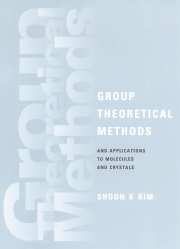Book contents
- Frontmatter
- Contents
- Preface
- List of symbols
- 1 Linear transformations
- 2 The theory of matrix transformations
- 3 Elements of abstract group theory
- 4 Unitary and orthogonal groups
- 5 The point groups of finite order
- 6 Theory of group representations
- 7 Construction of symmetry-adapted linear combinations based on the correspondence theorem
- 8 Subduced and induced representations
- 9 Elements of continuous groups
- 10 The representations of the rotation group
- 11 Single- and double-valued representations of point groups
- 12 Projective representations
- 13 The 230 space groups
- 14 Representations of the space groups
- 15 Applications of unirreps of space groups to energy bands and vibrational modes of crystals
- 16 Time reversal, anti-unitary point groups and their co-representations
- 17 Anti-unitary space groups and their co-representations
- Appendix Character tables of the crystal point groups
- References
- Index
5 - The point groups of finite order
Published online by Cambridge University Press: 12 November 2009
- Frontmatter
- Contents
- Preface
- List of symbols
- 1 Linear transformations
- 2 The theory of matrix transformations
- 3 Elements of abstract group theory
- 4 Unitary and orthogonal groups
- 5 The point groups of finite order
- 6 Theory of group representations
- 7 Construction of symmetry-adapted linear combinations based on the correspondence theorem
- 8 Subduced and induced representations
- 9 Elements of continuous groups
- 10 The representations of the rotation group
- 11 Single- and double-valued representations of point groups
- 12 Projective representations
- 13 The 230 space groups
- 14 Representations of the space groups
- 15 Applications of unirreps of space groups to energy bands and vibrational modes of crystals
- 16 Time reversal, anti-unitary point groups and their co-representations
- 17 Anti-unitary space groups and their co-representations
- Appendix Character tables of the crystal point groups
- References
- Index
Summary
Introduction
Any subgroup of the full rotation group in three dimensions O(3, r) (= O(3)) is called a point group, because all the group elements leave at least one point (the coordinate origin) in space invariant. Since there are a great deal of applications for the point groups of finite order, we shall discuss their group structures in greater detail. There exist five types of proper and nine types of improper point groups of finite order. A new system of notations for the latter is introduced by expressing an improper operation with the inversion or a rotation–inversion. This system is very effective in describing the isomorphisms between proper and improper point groups, because the inversion commutes with any point operation.
Following the historical development, we shall introduce a point group by the symmetry point group of a geometric body such as a regular polyhedron. The symmetry of a geometric body is defined by the set of all symmetry transformations which brings the body into coincidence with itself. By definition, such a set of transformations forms a group, the symmetry group G of the body. More specifically, let p be a point on the body, then a set of transformations which leaves the point p invariant forms a subgroup H of G.
- Type
- Chapter
- Information
- Publisher: Cambridge University PressPrint publication year: 1999

